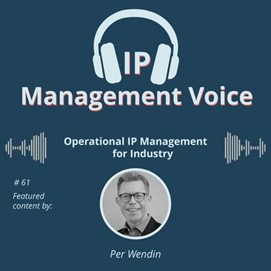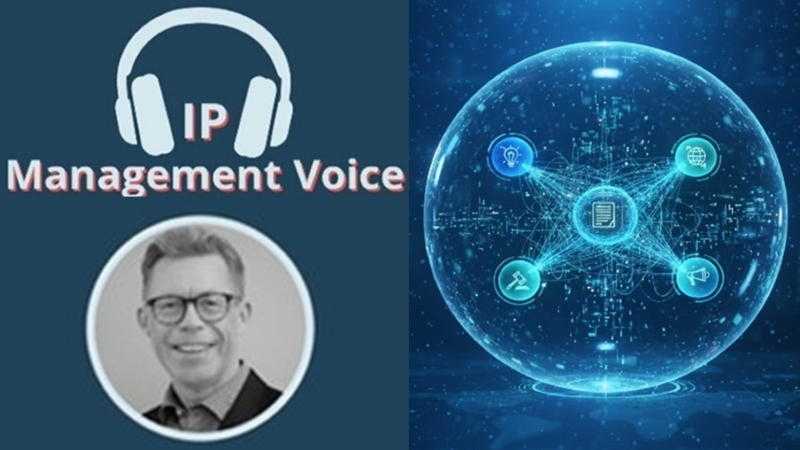Operational IP Management: Turning Protection into Growth
When most people hear the term “intellectual property,” their thoughts still drift toward dusty patent files, complex legal jargon, or perhaps a courtroom drama where innovation is defended in front of a judge. For decades, IP was considered a cost center — a necessary but somewhat distant function that followed innovation rather than guiding it.
That view is no longer sustainable. In today’s innovation-driven, hyper-competitive markets, intellectual property has become a central pillar of business strategy. As industries move faster, product lifecycles shorten, and global competition intensifies, IP can no longer sit quietly in the IP department. It must operate at the speed of innovation itself.
In a recent episode of 🎧IP Management Voice, Subject Matter Expert Per Wendin outlined this transformation. He explained that Operational IP Management (OIPM) is not about adding new bureaucracy but about embedding IP decisions directly into the company’s everyday operations. It is a management discipline — an engine that helps organizations align their innovation processes, protect their competitive edges, and drive growth with confidence.
From Reactive to Proactive
The essential shift Wendin describes is from reactive protection to proactive value creation. In the past, companies would develop their products first and only later, as a final step, ask the IP team to “file something.” That approach may have worked when product cycles were measured in years. Today, it’s a recipe for risk.
OIPM integrates IP into every stage — from the first spark of an idea to market launch. Instead of treating IP as an afterthought, companies now design protection strategies around their business goals and technology roadmaps. The outcome is a system that not only secures innovation but also accelerates it, enabling teams to make informed decisions early and avoid costly rework later.
In fast-moving industries, that shift can determine who leads and who lags behind.
The Four Strategic Foundations
Per Wendin frames Operational IP Management around four strategic foundations. The first is alignment with the business strategy. IP can never exist in isolation; it must follow the company’s direction. A firm aiming for rapid international scaling will shape its IP portfolio differently than one competing on unique design or proprietary processes. The question is not what can be protected, but what should be protected to support growth.
The second foundation is using IP as a driver of business development, not merely a legal shield. IP rights can open doors for partnerships, cross-licensing, and even mergers or acquisitions. Well-managed portfolios can generate direct licensing revenue or simply strengthen a company’s negotiation position. IP thus becomes both a sword and a bridge — a mechanism to create access, credibility, and leverage.
Third, competitive landscape analysis transforms IP into a radar system. Through patent analytics and continuous monitoring, companies can spot emerging trends, anticipate competitor moves, or identify so-called “patent white spots” — unoccupied innovation territories. These insights help organizations steer their research resources more intelligently and sometimes discover opportunities they didn’t know existed.
Finally, financial transparency is indispensable. Every euro or dollar spent on IP should serve a clear purpose: mitigating risk, creating value, or enabling strategy. Instead of tracking only how many patents are filed, companies should ask whether those patents actually contribute to competitive advantage. A mature OIPM system prunes outdated IP assets, redirects funds toward high-impact filings, and ensures that IP spending is treated like any other investment — with expected returns and measurable outcomes.
The Operational Dimensions
While strategy provides direction, operations deliver results. Wendin defines four key dimensions for putting OIPM into practice. The first is aligning R&D and IP strategies. IP experts must be involved at the very beginning of research projects, not only at the end. Many companies still discover too late that an innovation isn’t protectable — or that it was disclosed publicly before filing. Early integration avoids those expensive mistakes and makes protection a natural part of the R&D process.
The second dimension is the integration of IP into innovation workflows. This means establishing structured invention-disclosure processes, collaborative evaluations with technical and business experts, and clearly defined “IP checkpoints” within projects. With the right digital tools and training, filing an invention disclosure becomes as intuitive as submitting a design sketch or test report.
The third dimension focuses on protecting IP during product development. Collaboration is both a source of creativity and a source of risk. Contracts with partners, suppliers, or joint developers must contain clear IP clauses, NDAs, and ownership rules. Internally, awareness of confidentiality and data management is essential. Timing is equally critical: filing too early can weaken claims; filing too late can lead to loss of rights. Successful OIPM finds that “golden window” where the innovation is mature enough to claim but still undisclosed.
The fourth operational dimension is avoiding infringement of third-party rights. Freedom-to-Operate (FTO) analyses must be continuous, not one-off checks. In dense patent landscapes, proactive searches, licensing strategies, or even selective acquisitions may be necessary to secure FTO. Cultural awareness plays a role here too: engineers and developers need guidance on how to deal with competitor’s patents they encounter and how to use open-source elements responsibly. In many organizations, this cultural component determines whether IP management succeeds or remains theoretical.
Managing the IP Portfolio
Once IP is embedded into development processes, the organization faces another challenge — managing the growing body of rights efficiently. Wendin calls this Operational IP Portfolio Management. It begins with a living inventory that tracks all IP assets — patents, trademarks, designs, domain names, licenses, and trade secrets — along with their costs, owners, jurisdictions, and business relevance.
Yet listing them is not enough. Each IP asset must have a defined function within the business strategy: to block competitors, enable brand differentiation, generate licensing income, or support collaboration. Regular IP portfolio reviews help to ensure alignment with changing corporate priorities.
Equally important is reporting. Executives need high-level dashboards showing cost-benefit relations and strategic coverage; IP teams require detailed operational data. Clear reporting connects IP performance to business outcomes, fostering trust and accountability across departments.
Ultimately, IP portfolio management is a continuous cycle of investment and divestment. Companies should expand protection where growth potential is high and consciously withdraw from areas that no longer add value. This dynamic equilibrium keeps the portfolio lean, strategic, and financially healthy.
The Missing Piece: How the IP Department Is Organized
Operational IP Management cannot function in a vacuum. Its effectiveness depends heavily on how the IP department itself is structured within the organization. The design of the IP function — its mandate, reporting line, and role definition — determines how well OIPM principles can be executed.
If the IP unit is positioned purely as a legal service, disconnected from R&D or business development, it often lacks visibility and influence. In such setups, IP remains reactive, documenting rather than driving innovation. By contrast, organizations that treat the IP function as a strategic asset center — with dedicated budgets, cross-functional integration, and direct reporting to senior management — achieve far greater agility and impact.
We can distinguish several models: the Protection Centre, focused on safeguarding rights; the Differentiation Centre, supporting product and brand differentiation; the Profit Centre, generating direct revenue; and the Asset Centre, managing IP as an investment class. The transition from Protection to Asset Centre reflects the maturity curve that Wendin describes in OIPM — from compliance to contribution.
Another structural question concerns insourcing versus outsourcing. In-house teams provide continuity and deep business understanding, but they require sustained investment. Outsourced IP services, while cost-efficient, often struggle to align with evolving strategic priorities. The optimal balance depends on company size, industry complexity, and the level of strategic integration desired.
Ultimately, a company’s ability to operationalize IP depends on how clearly the IP function is empowered to act as a bridge between technology, law, and business. Without this organizational foundation, even the best OIPM frameworks risk remaining concepts rather than daily practice.
Building a Culture of IP Awareness
Beyond structure, culture defines success. Wendin emphasizes that engineers do not need to become legal experts — but they must understand the basics of protectability, disclosure risk, and the strategic role of IP. When IP awareness becomes part of the organizational mindset, teams naturally involve IP professionals early, share information responsibly, and think in terms of long-term advantage rather than short-term delivery.
That cultural integration requires leadership. Management must communicate that IP is not only about protection but also about firm performance. Regular cross-functional meetings, internal success stories, and clear metrics can reinforce this perspective. In mature organizations, the IP function is perceived less as a compliance cost and more as a growth enabler.
From Protection to Growth
 As the podcast concludes, operational IP management is ultimately about confidence. When legal, technical, and business perspectives are merged, companies can innovate faster, negotiate stronger, and invest smarter. In a digital business environment where differentiation is fleeting and imitation almost instantaneous, mastering the operational side of IP management becomes a decisive competitive advantage.
As the podcast concludes, operational IP management is ultimately about confidence. When legal, technical, and business perspectives are merged, companies can innovate faster, negotiate stronger, and invest smarter. In a digital business environment where differentiation is fleeting and imitation almost instantaneous, mastering the operational side of IP management becomes a decisive competitive advantage.
The lesson is clear: innovation alone does not build market leadership. What truly differentiates sustainable innovators is their ability to manage, protect, and leverage their intellectual assets at every operational level.
Operational IP Management, supported by a well-organized IP department and a culture of strategic collaboration, turns intellectual property from a static protection mechanism into a growth engine.
Listen to Episode #61 of 🎧IP Management Voice to gain insights into operational IP management from a practical perspective.



